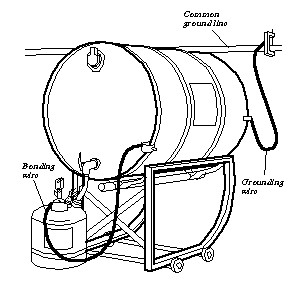

Bonding and Grounding
By Grainger Editorial Staff 4/28/21
Quick Tips #255.1
The process of bonding and grounding can be defined as providing an electrically conductive pathway between a dispensing container, a receiving container and an earth ground. This pathway helps eliminate the buildup of static electricity by allowing it to safely dissipate into the ground.
Both the National Fire Protection Association (NFPA) and the Occupational Safety and Health Administration (OSHA) have bonding and grounding requirements.
NFPA addresses the need for bonding and grounding in NFPA 30, the Flammable and Combustible Liquids Code. In the 2021 edition of NFPA 30, 18.4.4.1 states that dispensing of Class I liquids from a container by means of air is only permitted under the following conditions:
- The pressure must be generated by means of a listed hand-operated device,
- Must not exceed six pounds per square inch (psi) gauge pressure,
- A pressure relief must be provided, and
- The device must be bonded and grounded or not be capable of generating a static charge under any operating condition.
Where the use, handling, and storage of flammable or combustible liquids is only a limited activity (incidental operation), per 18.5.2.2, means must be provided to minimize generation of static electricity that meet the requirements of 6.5.4. All equipment (tanks, machinery, piping, etc.) must be designed an operated to prevent electrostatic ignition. All metallic equipment where the potential for an ignitable mixture to be present must be bonded and grounded.
OSHA’s requirements for bonding and grounding in general industry are referenced in the Flammable Liquids Standard, 29 Code of Federal Regulation (CFR) 1910.106(e)(6)(ii). The regulation states, “Category 1 or 2 flammable liquids, or Category 3 flammable liquids with a flashpoint below 100°F (37.8° C), shall not be dispensed into containers unless the nozzle and container are electrically interconnected. Where the metallic floorplate on which the container stands while filling is electrically connected to the stem or where the fill stem is bonded to the container during filling operations by means of a bond wire, the provisions of this section shall be deemed to have been complied with.”
This means all containers of Category 1, 2 or 3 liquids (liquids with a flashpoint lower than 100° F) need to be bonded and grounded during dispensing. This includes non-metallic containers, even though the construction material may not be recognized as conductive (for example, polyethylene). If the containers are not properly bonded and grounded, the resulting static spark could be capable of raising the vapor temperature above the flashpoint, causing an explosion.
Common examples of Category 1 liquids include acetaldehyde and ethyl ether. Examples of Category 2 liquids are acetone, benzene, and toluene. Styrene and turpentine (mineral spirits) are examples of Category 3 liquids. The flashpoint for a chemical can be found in section nine of the safety data sheet (SDS).
The diagram below is an example of a complete bonding and grounding system. The bonding wire is shown connecting the lid of the receiving container to the dispensing container. The grounding wire is shown connecting the dispensing container to the common ground within the facility. The common ground is in turn connected to an earth ground. Any ground source that is adequate for power circuits or lightning protection is sufficient for protection against static electricity. This system provides an electrically conductive pathway for static electricity to follow and safely dissipate into the ground.
For bonding and grounding to be effective, a metal-to-metal connection must be maintained between the bonding and grounding wires and the containers. To accomplish this, all paint, dirt, rust, etc., must be removed from the area of connection. These connections can be of two basic types: permanent or temporary. Permanent connections can be made by using solid or braided wires, and must incorporate either screw-type clamps, welding or other similar means. Temporary connections should use only braided wires in conjunction with spring clamps, magnetic clamps or other similar methods of maintaining metal-to-metal contact.

Solid wire is a single, complete strand of wire that is not known for its durability. For this reason, solid wires should only be used for permanent connections, or those that will not be handled often. Braided wires consist of several strands of wire wrapped together to provide greater strength and flexibility. Because of these characteristics the 2019 edition of NFPA 77 Recommended Practice on Static Electricity advises the use of braided wires when the wires will be frequently connected and disconnected in 7.4.1.4. The minimum size (gauge) of the wires is determined by strength and durability rather than current-carrying capabilities.
Additionally, in 7.4.1.5, NFPA 77 notes that either insulated or uninsulated wires can be used for bonding and grounding but uninsulated wires are recommended because they allow for easier detection of defects. Insulated wires are those with a protective rubber or vinyl coating that completely encompasses the wire. The insulation offers additional protection from fraying and corrosion. Regardless whether an insulated or uninsulated wire is used, they should frequently be checked for continuity.
Sources
29 CFR 1910.106
National Fire Protection Association,
NFPA 30, Flammable and Combustible Liquids Code (2021 edition)
National Fire Protection Association, NFPA 77, Recommended Practice of Static Electricity (2019 edition)
Frequently Asked Questions
Q: Where do I bond and ground a polyethylene safety can?
A: Manufacturers of OSHA-compliant polyethylene safety cans include a grounding lug for the connection of bonding and grounding wires.
Q: Do safety cabinets have to come with a grounding lug?
A: There are no regulations or codes that require grounding a flammable liquids safety cabinet. But, it is critical to do so if you are dispensing Category 1 flammable liquids from inside a metal flammable cabinet. Not only could the inside of the cabinet rapidly fill with ignitable vapors, the cabinet also has a large metal surface and metal shelves to discharge static against. Most metal flammable liquids safety cabinets come with exterior grounding lugs in place.
Q: Is it acceptable to hold the nozzle of the dispensing container in contact with the opening of the receiving container rather than attaching a bonding wire?
A: No. This is not an acceptable practice because it is difficult to maintain an electrical bond between these two items. Bonding wires should be used to ensure a safe bond is made and maintained between the two containers.
The information contained in this article is intended for general information purposes only and is based on information available as of the initial date of publication. No representation is made that the information or references are complete or remain current. This article is not a substitute for review of current applicable government regulations, industry standards, or other standards specific to your business and/or activities and should not be construed as legal advice or opinion. Readers with specific questions should refer to the applicable standards or consult with an attorney.







